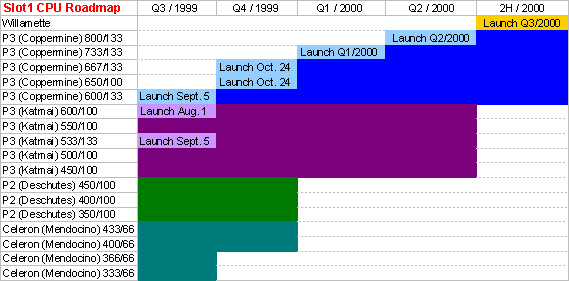Intel Roadmap Update June 1999 Part 2: Desktop CPU Roadmaps
Slot1
Slot1 is a dying processor platform, because the clumsy cartridge won't be needed anymore once Katmai and Deschutes are gone. It's hard to believe, but you'll soon find the faster CPUs on Socket370.
It seems as if Pentium II as well as Celeron will be discontinued for Slot1 by the end of this year.
Willamette:
It is not quite correct including Willamette into the above Slot1-chart, because it will run on a completely new platform, but it will be the successor of Pentium III and thus it fits quite well here. This processor will represent the next architecture (P7) for IA32, Intel's 32-bit processor line. The transition from P6 to P7 will most likely be like the transition form Pentium to Pentium II or from the 486 to Pentium. We don't know much about this CPU yet, except that it is supposed to be manufactured in .13µ-technology and that the architecture will be significantly superior to P6 (Pentium Pro, Pentium II, Pentium III). Willamette's `server-brother' will be `Foster', but it's not yet clear if the structure of Foster will be as close to Willamette as the structure of `Cascades' is to `Coppermine'.
Pentium III (Coppermine):
This upcoming processor will use a Pentium III core such as the currently shipping Pentium III with 'Katmai'-core, but Coppermine will include 256 kB of 2nd level cache on-die. Thus this CPU doesn't really require the cartridge packaging anymore, because it doesn't require any external components such as the current Pentium III or Pentium II, which both use external L2-cache modules. Coppermine will run its smaller L2-cache at core clock speed, whilst the current PIII (Katmai) and the PII run the L2-cache only at 1/2 the core clock speed. I expect that Coppermine's performance will be superior to the performance of Katmai, just as the performance of `Dixon' (aka `Mobile Pentium II (PE) = Coppermine minus SSE) turned out to be superior to Deschutes (Mobile Pentium II) in the notebook sector. Coppermine will be released in versions for 100 MHz as well as 133 MHz front side bus and it's manufactured in .18µ-technology.
Pentium III (Katmai):
Get Tom's Hardware's best news and in-depth reviews, straight to your inbox.
When Intel released Pentium III a few months ago, they introduced it in form of the .25µ-Katmai-core. This core does not include any second-level cache on-die, which is why it only comes as Slot1-solution, to host the external L2-cache chips we already know from Pentium II. Katmai will not disappear right after the release of Coppermine, all upcoming Pentium III processors at speeds of up to 600/100 MHz will use the Katmai-core for the time being. It's important to bear in mind that Katmai will most likely be some 5-10% slower than Coppermine at the same clock speed, which is why Intel delays the release of Coppermine for Socket370. If Intel wouldn't do that, a Socket370-Pentium III 550 would be faster than a Slot1-Pentium III 550 due to the different cores. That would turn Intel's world around as you can imagine.
